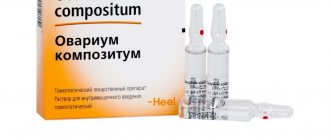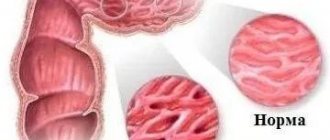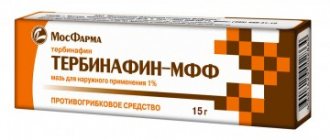0
Author of the article: Marina Dmitrievna
2017.12.19
943
Drugs
In a healthy person, the heart beats smoothly and its beats are not felt. Only in moments of excitement or joy can you feel your heartbeat. During sleep, the heart rate slows down, and during physical activity it naturally increases. The heart makes about 100 thousand beats per day.
However, many people with heart disease have irregular heartbeats. Effective treatments for such conditions include rhythmylene; instructions for use of the drug contain all the necessary information about dosages, indications and contraindications for its use.
Pharmacological properties of the drug Aritmil
Antiarrhythmic drug. The mechanism of action is due to the blocking of ion channels of the cell membranes of cardiomyocytes (mainly potassium and to a small extent calcium and sodium). Increases the duration of the action potential and the effective refractory period in all parts of the conduction system of the heart, including the sinus and AV node and the ventricles. Reduces the automaticity of the sinus node and ectopic foci, prolongs conduction in Purkinje fibers and additional conduction pathways in patients with WPW syndrome. The drug exhibits an antianginal effect, which is due to its antiadrenergic effect. The drug non-competitively blocks α- and β-adrenergic receptors. Amiodarone slightly reduces peripheral vascular resistance and systemic blood pressure. The drug contains approximately 37.3% iodine by weight, is highly lipophilic, and after oral administration is absorbed slowly and incompletely (20–55% of the dose taken). After a single dose, the maximum concentration in the blood is established after 3–7 hours; has a large and variable volume of distribution as a result of intensive accumulation in fatty tissue and organs with intense circulation and blood supply (liver, lungs, spleen). The binding to plasma proteins is 96%, and 10–50% of the drug penetrates the placental barrier; ¼ of the administered dose passes into breast milk. Intensively metabolized in the liver to form an active metabolite - desethylamiodarone. The main route of excretion is with bile. The half-life of the drug during long-term therapy is 53±24 days. The half-life of desethylamiodarone averages 61 days. After cessation of treatment, the therapeutic level of amiodarone in the blood plasma remains for 9 months. Not excreted during hemodialysis.
Indications for use of the drug Aritmil
Tablets Prevention and treatment of paroxysmal heart rhythm disturbances: sinus tachycardia, supraventricular tachyarrhythmia, including atrial flutter and fibrillation, ventricular tachyarrhythmia, ventricular and supraventricular extrasystole; rhythm disturbance in patients with WPW; prevention of angina attacks (stable, unstable, spontaneous) in patients with cardiac arrhythmias in whom treatment with other antiarrhythmic drugs has proven ineffective or contraindicated. Solution for injection Prevention of relapses: life-threatening ventricular tachycardia or ventricular fibrillation; ventricular tachycardia (documented) with clinical manifestations leading to disability; supraventricular tachycardia (documented) in patients with heart disease; rhythm disturbances due to resistance or the presence of contraindications to other methods of treatment; WPW s-ma. In order to slow down the rhythm of ventricular contractions or restore sinus rhythm during atrial fibrillation and flutter.
Heart pathologies and their consequences
Each contraction of the heart muscle triggers an electrical impulse, which is created by special cells in the organ itself, they are called “pacemakers.” With a normal heartbeat, at regular intervals, a sequential contraction of the parts of the heart occurs: the atria and ventricles. But when disturbances occur in the conduction system, the heart begins to beat irregularly: too fast or too slow. With arrhythmia, a disorder occurs between the functioning of the parts of the heart, and the atria contract chaotically.
Rhythm disturbances bother many people, and some types of arrhythmias respond well to drug therapy. However, there are also forms of the disease that pose a serious danger to human health and life.
With tachycardia, the ventricles do not have time to fill with blood and, accordingly, release the required amount into the arteries. As a result, blood flow to the organs is weakened, which leads to chronic oxygen starvation of the body's cells. There is an increased risk of developing coronary artery disease and myocardial infarction.
Atrial fibrillation reduces quality of life. The patient cannot fully work and live normally with the feeling of interruptions in heart rhythm.
In heart failure or tachysystolic cardiomyopathy, all the patient’s organs also experience chronic hypoxia. The most dangerous consequence of slow blood flow is thromboembolism. Most often, blood clots occur in the cavity of the left atrium. Their appearance leads to strokes and other dangerous complications.
Use of the drug Aritmil
Pills:
- For life-threatening arrhythmias
- orally, the daily dose is 800–1600 mg (it is better to divide into 2–4 doses during the day and take with food, especially at a dose of more than 1000 mg, and in patients with gastrointestinal disorders) for 1–3 weeks or longer;
- after achieving a therapeutic effect, the daily dose is reduced to 400–800 mg (in 2 divided doses) for about 1–3 weeks, and then switched to a maintenance dose of 400 mg (in 1–2 divided doses) and even 200 mg 1 time per day in during the required course of treatment.
- For various arrhythmias
- paroxysmal supraventricular tachycardia - the dose is 600 mg/day for 8–15 days; maintenance dose - 100–200 mg/day;
- paroxysmal fibrillation and atrial flutter - the dose is 600–800 mg/day for 15–30 days (sometimes up to 1000 mg/day); maintenance dose 300–400 mg/day with a gradual reduction by 200 mg/day every 15–30 days;
- potentially dangerous ventricular arrhythmias (frequent, paired ventricular extrasystoles, repeated episodes of ventricular tachycardia) - therapeutic dose of 600–800 mg/day; maintenance - 300–600 mg/day;
- frequent paroxysms of ventricular tachycardia or repeated episodes of ventricular fibrillation - the average dose is 1000 mg / day for 15-30 days, the maximum daily dose in some cases is up to 2000 mg for 7-10 days; average maintenance dose - 700 mg/day (600–800 mg/day);
- arrhythmias in children - it must be taken into account that in children the therapeutic effect of the drug manifests itself faster and the duration of action is shorter than in adults. The initial daily dose for children is on average 10 mg/kg body weight for 10 days or until a therapeutic effect is achieved. After achieving the desired results, the daily dose is reduced to 5 mg/kg. The maintenance daily dose is 2.5 mg/kg.
Solution for injection For intravenous administration, the dose and frequency of use are determined individually. IV injection: the usual dose is 5 mg/kg, administered over at least 3 minutes. The intravenous injection can be repeated no earlier than 15 minutes after the first administration, even if only part of the contents of one ampoule was used. The therapeutic effect appears within the first minutes after administration of amiodarone and then gradually decreases. In this regard, intravenous infusion is necessary to maintain a stable effect. IV infusion: the initial dose is usually 5 mg/kg (0.3-0.4 g) in 250 ml of 5% glucose solution over 20 minutes - 2 hours; administration can be repeated 2-3 times within 24 hours. The rate of infusion should be adjusted according to the results. The maximum daily dose should not exceed 1200 mg/day. Maintenance dose: 10–20 mg/kg/day (average 600–800 mg/day up to 1200 mg/day) in 250 ml of 5% glucose solution for several days. Infusion therapy is usually continued for 4–5 days. From the first day of infusion, it is necessary to begin a gradual transition to oral administration. To relieve arrhythmias in emergency situations, Aritmil is administered to children at a dose of 5 mg/kg IV slowly (over 1–3 minutes) in a 5% glucose solution, then switched to a maintenance drip infusion of Aritmil in the same dose, diluted in 100 –250 ml of 5% glucose solution and infused over 0.5–2 hours.
Causes, risks and diagnosis of heart disease
The causes of heart disease are varied. Arrhythmias in adults often occur against the background of serious illnesses. One of the common causes of arrhythmia is coronary heart disease. Atrial fibrillation often occurs due to acquired heart defects or rheumatism.
Fibrillation
Ventricular arrhythmias accompanied by ischemic disease can lead to sudden arrhythmic death, which kills 200-250 thousand people in the country every year. Moreover, 60% of patients are unaware of their heart rhythm disturbances.
Atrial fibrillation can occur with clinical manifestations or asymptomatically - this form is the most dangerous.
To identify abnormalities, cardiologists strongly recommend taking an electrocardiogram annually. With its help, it is easy to determine whether the heart is beating in the correct rhythm. An ECG also helps monitor your heart rate. The normal rate in an adult is 60-90 beats per minute. During high physical activity or during excitement, an increased heart rate is normal. However, if the indicators go off scale during periods of rest, such conditions are classified as pathological rhythm disturbances.
Modern diagnostic methods make it possible to obtain accurate information about heart diseases.
The most valuable study that helps identify the most dangerous forms of fibrillation is 24-hour Holter monitoring. The essence of the procedure is that a continuous recording of the patient's electrocardiogram is made for 24 hours. Then the number of pathological episodes that occurred during the day and their duration are calculated. The purpose of the method is to determine the type of disturbance, rhythm and heart rate.
ECG for cardiac pathologies
To search for pathologies that provoke tachycardia and the causes of fibrillation, echocardiography or MRI of the heart is performed. Once the diagnosis is made, the patient is prescribed special antiarrhythmic drugs. In most cases, they block episodes of tachycardia and arrhythmia for a long time.
Side effects of the drug Aritmil
from the cardiovascular system - bradycardia (the degree depends on the dose) is often asymptomatic, but it can also be accompanied by clinical symptoms, sinoatrial or AV block is possible. Proarrhythmic effects of Aritmil, the development and worsening of existing arrhythmias may cause dysfunction of the thyroid gland, including in connection with taking the drug. Development (exacerbation) of symptoms of heart failure. From the digestive system - anorexia, nausea, vomiting, constipation, metallic taste in the mouth. From the autonomic and central nervous system - paresthesia, tremor, headache, fatigue, myopathy, retrobulbar neuritis, in isolated cases - benign intracranial hypertension, nightmares, auditory hallucinations; unusual weakness in the muscles of the limbs; ataxia is the most common side effect that can occur some time after the start of therapy and persist for a long time (up to 1 year) after discontinuation. From the respiratory system - pneumonia (with possible death), fibrosis, pleurisy, bronchitis, bronchospasm (especially in patients with severe respiratory failure or asthma). On the part of the organ of vision - deposition of lipofuscin in the corneal epithelium; complaints about the appearance of colored halos or blurred contours; rarely - neuropathy or optic neuritis. On the part of the endocrine system - with long-term use, hypothyroidism may occur, and, less commonly, hyperthyroidism. Dermatological reactions - photosensitivity, lead-blue or bluish pigmentation of the skin, skin rash, rarely - alopecia, allergic reactions. Others - sometimes vasculitis, renal dysfunction, thrombocytopenia, hemolytic or aplastic anemia. If any adverse reactions occur, you must stop using the drug.
Special instructions for the use of the drug Aritmil
Tablets Aritmil should only be prescribed by a doctor with experience in the treatment of heart rhythm disorders! The drug is prescribed to elderly patients with caution, as the risk of side effects increases. Before starting treatment, each patient must have an ECG and determine the levels of thyroid-stimulating hormone and potassium in the blood plasma. When prescribing Aritmil to patients with heart failure, simultaneous use of cardiotonic drugs may be required. If side effects develop (including if the heart rate is less than 55 beats/min), treatment should be discontinued. If symptoms of hyperthyroidism appear, the drug should be discontinued. During long-term treatment with the drug, insolation should be avoided, which is due to the increased likelihood of developing sunburn. Approximately 25% of the dose taken by the mother is found in breast milk, and therefore it is not recommended to prescribe Aritmil during breastfeeding. Solution for injection Use with caution in case of electrolyte imbalance, as there are isolated reports of the development or progression of arrhythmias (up to cardiac arrest). It should be taken into account that when using Aritmil, ECG changes are possible: prolongation of the Q-T with the possible appearance of a U . It should be taken into account that in elderly patients there is a more pronounced decrease in heart rate. If II-III degree AV blockade, sinoatrial or bifascicular blockade occurs, treatment with Aritmil should be discontinued. It should also be taken into account that after discontinuation of the drug, the pharmacodynamic effect persists for 10–30 days. Arythmil contains iodine (200 mg of the drug contains 75 mg of iodine), so it may affect the results of tests for the accumulation of radioactive iodine in the thyroid gland. Before starting treatment, during it and for several months after the end of treatment, it is necessary to conduct studies of thyroid function. During treatment, an ophthalmological examination should be performed, liver function should be monitored, and an X-ray examination of the lungs should be performed. To avoid the development of photosensitivity, patients should avoid exposure to the sun or use effective protective agents (protective creams). It should be taken into account that there have been rare cases of the development of acute respiratory distress syndrome in adults immediately after surgical interventions. Therefore, before the operation, the anesthesiologist must be informed that the patient was administered Aritmil. The drug is prescribed with caution to elderly people (risk of developing bradycardia), vehicle drivers and people whose profession is associated with increased concentration.
Cordarone®
Amiodarone may cause severe adverse reactions in the heart, thyroid, eyes, lungs, liver, skin, and peripheral nervous system. Since these adverse reactions may be delayed, patients taking Cordarone® for a long time should be closely monitored throughout the entire period of treatment, as well as for several months after its cessation.
Side effects of the drug Cordarone® are usually dose-dependent, therefore, to minimize the possibility of their occurrence, the minimum effective dose should be used.
Heart disorders
Before starting to take the drug Cordarone®, it is recommended to conduct an electrocardiographic study (ECG) and determine the potassium content in the blood serum. Hypokalemia must be corrected before using Cordarone®.
The pharmacological effect of the drug Cordarone® causes ECG changes: prolongation of the QT interval, QTC (corrected), associated with an extension of the period of repolarization of the ventricles of the heart, with the possible appearance of U waves. However, these changes are not a manifestation of the toxic effect of the drug Cordarone®. It is permissible to increase the QTC interval by no more than 450 ms or by no more than 25% of the original value.
The use of amiodarone in high doses can lead to the development of severe bradycardia and cardiac conduction disturbances with the appearance of idioventricular heart rhythm, especially in elderly patients and with simultaneous use of cardiac glycosides. In such cases, the use of the drug should be discontinued. If necessary, beta-agonists or glucagon can be prescribed. Given the long half-life of amiodarone, the possibility of installing a temporary pacemaker should be considered.
Amiodarone can be used in patients with latent or manifest chronic heart failure. In this case, the drug should be used with caution in decompensated or severe chronic heart failure (III-IV functional class according to the NYHA classification), because Amiodarone in some cases can lead to its worsening.
Elderly patients are at increased risk of developing severe bradycardia when using amiodarone.
If first degree atrioventricular block occurs, monitoring of the patient's condition should be intensified. In the event of the development of atrioventricular block II and III degrees, sinoatrial block or two-beam/three-beam intraventricular block, treatment with Cordarone® should be discontinued.
The occurrence of new rhythm disturbances or worsening of existing rhythm disturbances, sometimes with fatal outcome, has been reported. It is very important, although difficult, to make a differential diagnosis between the insufficient antiarrhythmic effectiveness of the drug and its arrhythmogenic effect (regardless of whether it is combined or not with aggravation of the severity of heart disease).
When using the drug Cordarone®, arrhythmogenic effects were reported much less frequently than when using other antiarrhythmic drugs. It has generally been observed in the presence of factors that prolong the QT interval, such as interactions with other drugs and/or blood electrolyte disturbances. Despite its ability to prolong the QT interval, amiodarone has a low potential for torsade de pointes (TdP).
Patients with a pacemaker/implanted cardioverter-defibrillator
Increased frequency of ventricular defibrillation and/or increased threshold for pacemaker or implantable cardioverter defibrillator (ICD) response has been reported in patients receiving long-term antiarrhythmic drugs. Amiodarone may increase the pacing threshold in patients with a pacemaker and the defibrillation threshold in patients with an ICD. In this regard, to ensure adequate functioning of these implantable devices in patients receiving therapy with Cordarone®, it is recommended to regularly monitor pacing/defibrillation parameters.
Severe bradycardia with simultaneous use of amiodarone with antiviral drugs
When Cordarone® was used in combination with sofosbuvir in monotherapy or in combination with other direct-acting antiviral drugs against viral hepatitis C, such as daclatasvir, simeprevir, ledipasvir, cases of severe, potentially life-threatening bradycardia, as well as heart block, were observed. Therefore, the simultaneous use of these drugs with Cordarone® is not recommended.
If concomitant use of these drugs with Cordarone® cannot be avoided, careful monitoring of patients is recommended after starting sofosbuvir in combination with other direct-acting antivirals. After concomitant use of sofosbuvir is initiated, patients who are at high risk of developing bradyarrhythmias should be monitored continuously in a hospital setting for at least 48 hours.
Due to the long half-life of amiodarone, appropriate monitoring should also be performed in patients who have stopped taking Cordarone® within the last few months before starting treatment with sofosbuvir alone or in combination with other direct-acting antivirals.
Patients taking the above medicinal products against hepatitis C virus in combination with Cordarone®, either in combination with other medicinal products that slow the heart rate or without combination with such medicinal products, should be informed about symptoms indicating the development of bradycardia and heart block. hearts. If they occur, they should seek medical attention immediately.
Thyroid disorders
Amiodarone can cause the development of both hypothyroidism (decreased thyroid function) and hyperthyroidism (increased thyroid function), especially in patients with a history of thyroid disease.
Because amiodarone contains iodine, its use may interfere with the absorption of radioactive iodine and distort the results of radioisotope studies of the thyroid gland. However, taking the drug does not affect the reliability of determining the concentration of free triiodothyronine (T3), thyroxine (T4) and thyroid-stimulating hormone (TSH) (using an ultrasensitive assay) in the blood serum.
Before using amiodarone, all patients should undergo a clinical and laboratory examination (determining the concentration of TSH in the blood serum using an ultrasensitive assay) to identify abnormal thyroid function.
The patient should be monitored regularly (at 6-month intervals) during treatment with amiodarone and for several months after its cessation in order to identify clinical or laboratory signs of changes in thyroid function. Particularly careful monitoring is necessary when using the drug in elderly patients and in patients with a history of thyroid disease. If thyroid dysfunction is suspected, it is necessary to determine the concentration of TSH in the blood serum (using an ultrasensitive test).
Amiodarone inhibits the peripheral conversion of thyroxine (T4) to triiodothyronine (T3) and may cause isolated biochemical changes (increased serum free T4 concentrations with slightly decreased or even normal serum free T3 concentrations) in clinically euthyroid patients, which is not the cause to discontinue the drug Cordarone®.
Hypothyroidism
The development of hypothyroidism can be suspected when the following clinical signs appear: weight gain, cold intolerance, decreased activity, severe bradycardia. The diagnosis is confirmed by an increase in the concentration of TSH in the blood serum, determined using an ultrasensitive analysis. Normalization of thyroid function is usually observed within 1-3 months after cessation of treatment.
In life-threatening situations (for example, when using the drug for the prevention of life-threatening ventricular arrhythmias), treatment with Cordarone® can be continued with simultaneous additional use of levothyroxine drugs under the control of serum TSH concentrations.
Hyperthyroidism
While taking Cordarone® or for several months after stopping it, hyperthyroidism may develop. Particular attention should be paid to symptoms such as weight loss, asthenia, anxiety, emotional lability, rapid heartbeat, the occurrence or increase in rhythm disturbances and/or angina attacks, the occurrence or worsening of chronic heart failure. The diagnosis is confirmed by identifying a decrease in the concentration of TSH in the blood serum, determined using an ultrasensitive analysis. In this case, taking Cordarone® should be discontinued. Recovery usually occurs within several months after treatment is stopped; First, the disappearance of clinical manifestations is observed, and then normalization of laboratory parameters of thyroid function occurs. Severe cases of amiodarone-induced thyrotoxicosis, which can sometimes be fatal (both due to the thyrotoxicosis itself and due to a dangerous imbalance between myocardial oxygen demand and oxygen supply), require urgent treatment. Treatment should be selected individually in each specific case: antithyroid drugs (which may not always be effective), glucocorticosteroids, beta-blockers.
Visual disorders
Amiodarone may cause the development of neuropathy/optic neuritis. If blurred vision occurs or visual acuity decreases, it is necessary to urgently conduct a complete ophthalmological examination, including examination of the fundus (funduscopy). If neuropathy and/or optic neuritis is detected, Cordarone® should be discontinued due to the risk of their progression up to the development of blindness. Regardless of the presence or absence of visual impairment, with long-term use of the drug Cordarone®, an annual ophthalmological examination is recommended.
Lung disorders
Lung lesions (interstitial/alveolar pneumonitis or fibrosis, pleurisy, bronchiolitis obliterans with organizing pneumonitis), sometimes fatal, have been reported with the use of amiodarone. Manifestations of pulmonary toxicity include shortness of breath (which may be severe and not consistent with the severity of damage to the cardiovascular system), non-productive dry cough and deterioration of general condition (increased fatigue, weight loss, fever). Symptoms are usually mild at first but progress quickly. In most cases, lung lesions develop with long-term use of amiodarone, but in some cases they can occur a short time (from several days to several weeks) after the start of treatment.
A thorough clinical evaluation is recommended before use of amiodarone in all patients; In some cases, it is advisable to perform a chest x-ray. If the development of interstitial pneumonitis is suspected, an X-ray examination of the lungs and a study of pulmonary function should be performed.
Radiological manifestations in the initial stage of interstitial pneumonitis can be difficult to distinguish from congestion caused by left ventricular heart failure. If necessary, an additional examination should be performed (for example, determining the pulmonary wedge pressure using a Swan-Ganz catheter), and also exclude other possible causes of shortness of breath and other symptoms (infectious diseases of the lower respiratory tract, pulmonary embolism, malignant neoplasms, etc.). ). Interstitial pneumonitis is usually reversible with early discontinuation of amiodarone, with or without corticosteroid therapy. Clinical symptoms usually resolve within 3-4 weeks.
Improvement in X-ray patterns and lung function occurs more slowly (over several months). In some cases, despite discontinuation of amiodarone, lung damage remains irreversible.
In selected patients, after resolution of interstitial pneumonitis, resumption of amiodarone therapy at lower doses did not lead to recurrence of pulmonary toxicity.
Regardless of the presence or absence of symptoms of lung damage during treatment with Cordarone®, it is recommended to conduct an X-ray examination of the lungs and pulmonary function tests every 6 months.
In patients taking Cordarone®, in very rare cases, usually immediately after surgery, a serious respiratory complication (acute adult respiratory distress syndrome), sometimes fatal, has been observed; the possibility of a connection between its development and interaction with high oxygen concentrations is assumed.
Liver disorders
Various liver diseases (including jaundice, hepatitis, cirrhosis and liver failure) have been observed with the use of amiodarone. Severe liver damage with a fatal outcome has been observed mainly with long-term use of amiodarone, but in rare cases it can develop a short time after the start of treatment (especially with intravenous administration of the drug). It is recommended to evaluate the activity of liver transaminases (AST and ALT) and other indicators of liver function before starting amiodarone, as well as regular monitoring of liver function tests (monitoring the activity of liver transaminases) during treatment and for 6 months after its cessation .
If the activity of “liver” transaminases is 3 times or more higher than the upper limit of normal (ULN), the dose of amiodarone should be reduced or the drug should be stopped.
At the beginning of therapy, an isolated increase in the activity of “liver” transaminases from 1.5 to 3 slots above ULN may be observed. In such cases, liver function tests may return to normal values after reducing the dose of amiodarone.
In case of development of acute liver damage (increased activity, “liver” transaminases and/or jaundice), the use of the drug should be discontinued.
When using amiodarone for more than 6 months, the development of chronic liver damage has been described, which can be manifested by minimally expressed clinical signs (hepatomegaly) and changes in laboratory parameters (increased activity of “liver” transaminases from 1.5 to ≤ 5 times the ULN). Histological examination of liver biopsies reveals changes similar to alcoholic hepatitis or signs of cirrhosis. In such cases, regular monitoring of liver function tests is necessary. Typically, these clinical and laboratory changes are reversible and regress after discontinuation of amiodarone, but cases of progression to liver damage with fatal outcome have been reported.
Due to the potential risk of hepatotoxicity, Cordarone® should be used with extreme caution in patients with impaired liver function. During treatment, it is recommended to exclude (or at least limit) alcohol intake.
Skin and subcutaneous tissue disorders
Life-threatening or even fatal skin reactions such as Stevens-Johnson syndrome and toxic epidermal necrolysis have been reported with amiodarone use. Treatment with Cordarone® should be stopped immediately if a progressive skin rash, often with blistering, or damage to the mucous membranes appears. Amiodarone quite often causes photosensitivity. Patients should be warned to avoid exposure to direct sunlight or to take protective measures (eg, use of sunscreen, wearing appropriate clothing) during treatment.
Not th p muscle disorders
Cordarone® may cause peripheral sensorimotor neuropathy and/or myopathy. Recovery usually occurs within a few months after discontinuation of Cordarone®, but may sometimes be incomplete.
Drug interactions
The simultaneous use of the drug Cordarone® with the following drugs is not recommended: beta-blockers, blockers of “slow” calcium channels that slow down the heart rate (verapamil, diltiazem); laxatives that stimulate intestinal motility (can cause hypokalemia).
Primary graft dysfunction (PGD) within 24 hours after heart transplantation
The use of amiodarone before heart transplantation is associated with an increased risk of developing PDT (data from retrospective studies).
PTD is a life-threatening complication of heart transplantation, manifesting as dysfunction of the left, right, or both ventricles, and developing within 24 hours after heart transplantation for which no other cause has been identified.
In patients on the waiting list for heart transplantation, the possibility of using an alternative antiarrhythmic drug should be assessed as early as possible.
General and local anesthesia
Before surgery, you should inform the anesthesiologist that the patient is taking the drug Cordarone®. While taking the drug Cordarone®, it is possible to increase the hemodynamic risks inherent in local or general anesthesia (this especially applies to a slowdown in heart rate, slower conduction and decreased contractility of the heart).
Interactions of the drug Aritmil
When taken simultaneously with antiarrhythmic drugs (including bepridil, class IA drugs, sotalol), as well as vincamine, sultopride, erythromycin for intravenous administration, pentamidine for parenteral administration, the risk of developing ventricular tachycardia of the “pirouette” type increases, therefore these combinations are contraindicated. Antipsychotic drugs, derivatives of phenothiazine, butyrophenone, diphenylbutylpiperidine, antimalarial drugs - quinolone derivatives, second generation antihistamines: astemizole, terfenadine increase the risk of ventricular arrhythmia. Combination therapy with beta-adrenergic receptor blockers and some calcium channel blockers (verapamil, diltiazem) is not recommended, as disturbances in automaticity (manifested by bradycardia), conduction (AV blockade) and cardiodepressive effects may develop. It is not recommended to prescribe Aritmil together with laxatives and other drugs (diuretics, corticosteroids for systemic use, amphotericin B), which can cause hypokalemia, as the risk of developing ventricular tachycardia of the “pirouette” type increases. When used simultaneously with oral anticoagulants, the risk of bleeding increases (monitoring of prothrombin levels and adjustment of anticoagulant doses is necessary). When used simultaneously with cardiac glycosides, disturbances in automaticity (manifested by severe bradycardia) and atrioventricular conduction may be observed. In addition, it is possible to increase the concentration of digoxin in the blood plasma by reducing its clearance (it is necessary to monitor the concentration of digoxin in the blood plasma, monitor the ECG and, if necessary, change the dosage regimen). When used simultaneously with diphenin and cyclosporine, the concentration of the latter in the blood plasma may increase. Cases of bradycardia (resistant to atropine), arterial hypotension, conduction disturbances, and decreased cardiac output have been described in patients taking Aritmil and who underwent general anesthesia or oxygen therapy. Under strict control, you can prescribe the drug with anaprilin to summarize the effects. In combination with barbiturates, Aritmil depresses the central nervous system, which can lead to the development of depression. Cholestyramine reduces the half-life and reduces the level of amiodarone in the blood plasma, and cimetidine increases it. Concomitant use with drugs that have a photosensitizing effect increases the risk of this undesirable effect.
Treatment of heart diseases with the drug rhythmilene
The main active ingredient is disopyramide. Ritmilen belongs to the group of class Ia antiarrhythmic drugs and is a sodium channel blocker. Drugs in this group also affect the duration of depolarization phases. Rhythmilen regulates cardiac excitability, cellular conductivity and action potential of the heart muscle.
Indications for use:
- supraventricular and ventricular arrhythmia and extrasystole;
- chronic heart failure;
- supraventricular and nodal tachycardia;
- atrial flutter.
Class I antiarrhythmic drugs and their effect on the body
Overdose of the drug Aritmil, symptoms and treatment
It manifests itself as sinus bradycardia, AV block, paroxysmal ventricular tachycardia, ventricular tachycardia of the “pirouette” type, and arterial hypotension. There is no specific antidote; treatment is symptomatic. If you have recently taken the drug orally, it is advisable to induce vomiting and rinse the stomach. In case of bradycardia, atropine or β1-adrenergic agonists (dobutamine) are prescribed, and a pacemaker is used if necessary. For hypotension, drugs with cardiotonic effects or hypertensive drugs can be used. Arythmil and its metabolites are not excreted during dialysis.






